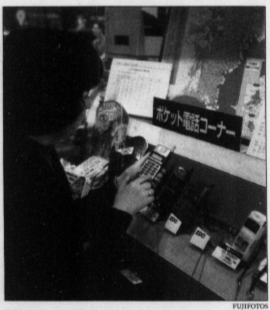Richard Ernsberger Jr. in Tokyo with Kay Itoi
Upstart Technology
Telephones: Everything that rings must converge?

ITS ONE OF THE MINOR INCONVENIENCES of urban life. Tomoaki Sato, a 30-year-old computer programmer in Tokyo, likes to call friends while in transit through the city's streets—but he loathes queuing up to use a public phone. He could buy a cellular phone, but finds them "too big and heavy” to carry around. Whut to do? Sato recently signed up for the latest in mobile-phone technology - Japan's Personal Handyphone System, a low-power, low-cost variation on cellular telephones that started operating in the Kanto region (encompassing Tokyo) on July 1. The new "microcelluiar" system has caught the eye of Japan's increasingly busy and cost- conscious consumers. tast week Sato was in Akihatara. Tokyo's electronics district, surveying a rack of sleek, light weight PHS phones. "Ill go for a small one that costs under 40.000 yen 184 70].” he said. “That's a nice price."
If Japan's PHS system catches on. as most analysts expect, it will be precisely because the price is right PHS handsets sell for nxighly two thirds the cost of ordinary cellular phones in Japan - and monthly subscription fees and calling charges are less than half as much Because PHS phones have a limited calling range, they are well suited for densely populated cities. "I'm quite optimistic about it," says James I Grey, a telecommunications analyst for Jar- I dine Fleming Securities in Tokyo. Three companies are offering the service in Japan, and they claim to have already signed up tens of thousands of customers, even though PHS phones cannot be used in cars or trains and the system's coverage area in metropolitan Tokyo is incomplete.
Japan's Ministry of Posts and Telecommunications has a lot riding on the new mobile-phone technolog)' Heretofore, the MI*T has been remarkably unsuccessful in getting other countries to adopt Japanese communications standards. In PHS it believes it has finally found a standard setter that can be exported to other nations, especially in Asia, thus enhancing the fortunes of Japan's electronics companies. Hutchison Communications, a major paging and cellular operator in Hong Kong, has already selected the PHS standard for its system-one of several to be started in the British colony soon. Other markets may prove harder to crack. The United Slates is developing seven different microcellular standards, and the European Union is tacking the Digital European Cordless Telephone system.
Competition: Though rosy forecasts abound, the success of PHS is by no means assured. Cellular operators in Japan and elsewhere have cut their fees dramatically over the last year in anticipation of the new threat, adding large numbers of subscribers. If cellular fees continue to fall, the principal competitive advantage of PHS might slowly disappear. Initially, PHS will he marketed mainly to students, housewives and other nonbusiness users. "My friends say that I'm never home and can never be found." says a 28-year-old woman inspecting PHS phones in a Akihatara retail shop. "When I heard of this service. I said this was made for me."
It may not be long, however, before cellular and microcellular systems start trying to poach each other's customers. Over time the two markets could blur—and there is likely to be a shakeout among the different mobile standards now emerging. "Eventually cellular and PCs systems will converge, and the cheapest standard will win.” says Grey. For first results, call tack in a year.
